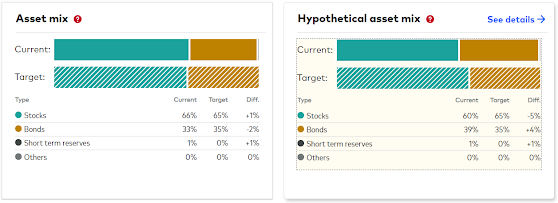Summary
For most individual investors, a simple 3-fund portfolio consisting of U. S. Stock Index, International Stock Index and Bond Index is the best way to invest in the market.
In the accumulation (saving for retirement) phase, Asset Location (taxable, tax-free, tax-deferred) i.e. where you place your investments, is as important as Asset Allocation for maximizing after-tax return.
Rebalancing your portfolio once a year is a good practice. It enables you to buy low and sell high automatically.
The Kiplinger article Using Asset Location to Defuse a Retirement Tax Bomb explains the strategy of asset location and why it is crucial to lowering tax bills in retirement.
As the article warns, implementing the optimal asset location strategy can be tricky if your portfolio consists of actively managed funds or ETFs that blend multiple asset classes. However, the implementation is greatly simplified if your portfolio consists of only 3 passively managed asset class pure index funds or ETFs.
In order to use the guidelines in this article, you should meet the following prerequisites.
Asset Allocation: You have determined your suggested asset mix using the Vanguard Investor Questionnaire or using some other tool of your choice.
Index Funds or ETFs only: Your portfolio consists of only 3 broad-based index funds or ETFs investing in total U.S. stocks, international stocks and bonds respectively.
In order to maximize your long-term after-tax returns (especially after retirement during the withdrawal phase), use the following approach to determine the asset location i.e. taxable, Roth IRA and tax-deferred accounts, for your stock and bond funds or ETFs:
First, place total bond index fund in Traditional IRA and 401(k) accounts. Note that taxes on current income from bond investments in these accounts would be deferred until withdrawal. Also, capital gains would be taxed as ordinary income when withdrawn from these accounts during retirement. Maximizing bond allocation in these accounts will result in lower total income and therefore, lower taxes.
Next, place any remaining total bond index fund in the Roth account. Income from bond investments in the Roth account will be sheltered.
Next, place total international stock index fund in the taxable account. This enables you to take advantage of any foreign tax credit. You cannot do this in a tax-advantaged account.
Finally, place total US stock index fund in the taxable account and in any remaining space in the Roth account. Place the remaining stock investments in any remaining space in the Traditional IRA and 401(k) accounts. Taxable accounts provide favorable capital gains treatment during the withdrawal phase and Roth accounts provide tax-free growth for stock investments.
If you need to make changes to your portfolio allocation and location, you can use Vanguard’s Portfolio Tester tool to test and rebalance your portfolio.
The following example shows the Portfolio Watch for the simple 3-fund portfolio in a single account that has the current allocation of 75/25 (stocks/bonds) with 10% of stocks in international stocks.
Let us suppose that our target allocation is 70/30 with 20% of stock allocation in international stocks. You can use the Portfolio Tester tool to make hypothetical changes to bring the portfolio to the desired target. Although this portfolio consists of a single account, the tool can also be used for testing changes across multiple accounts (taxable, Roth and tax-deferred).
Click "See Details" next to Hypothetical Asset Mix to see the detailed analysis including risk and return for both portfolios, using past 97 years' data (1926-2022).
Note, however, that your actual rebalancing decisions will depend on many factors, including, your capital gains tax bracket, your tax filing status (single, married filing jointly, etc.) and the amount of your potential taxable capital gains for the year.
Related:
Using Vanguard Investor Questionnaire to determine your asset allocation
Using Vanguard’s Portfolio Watch and Portfolio Tester for Rebalancing
What is the Capital Gains Tax and How is it Calculated? | Kiplinger
7 Rebalancing Strategies That Are Tax-Efficient, Too!
Asset location can lead to lower taxes. Here's how to get more value
Disclaimer: This article is not intended to be investment advice. Consult a duly licensed professional for investment advice. The contents of this article are for educational purposes only and do not constitute financial, accounting, tax, or legal advice. Past performance is no guarantee of future results.











